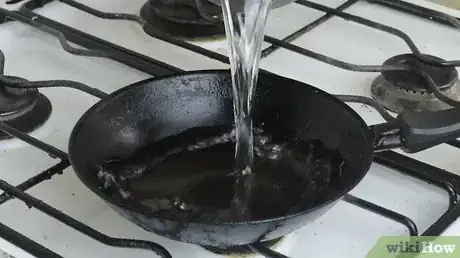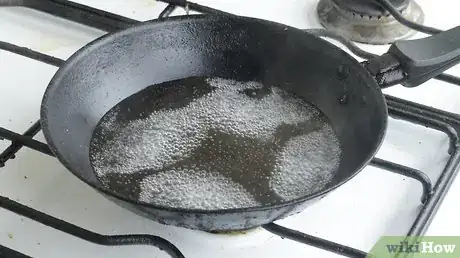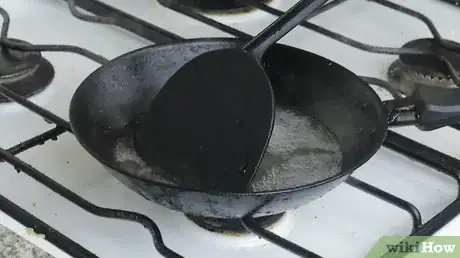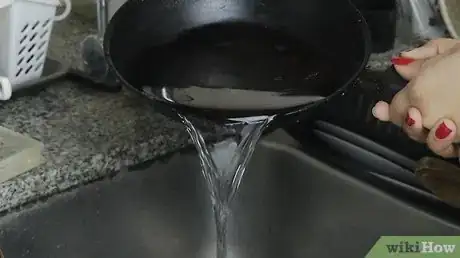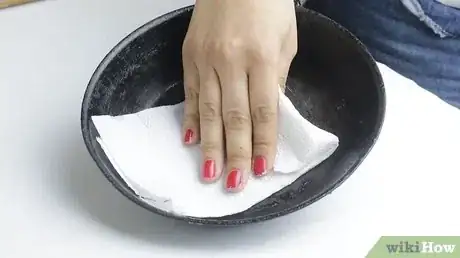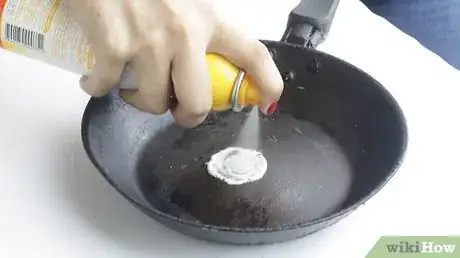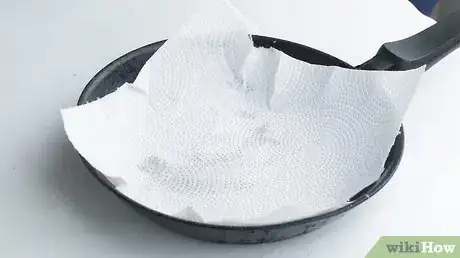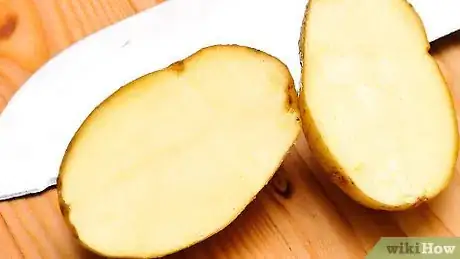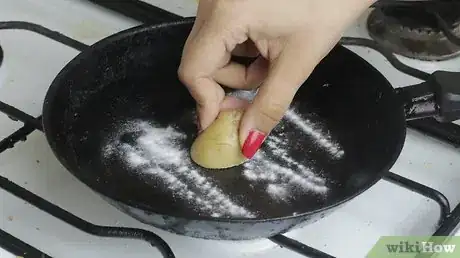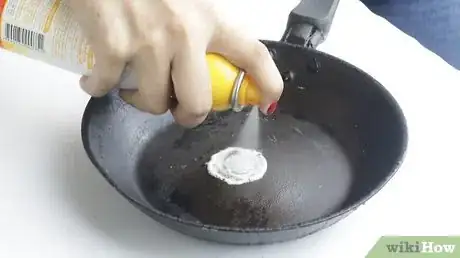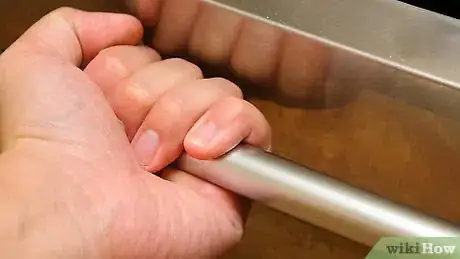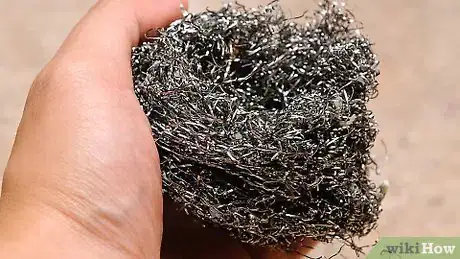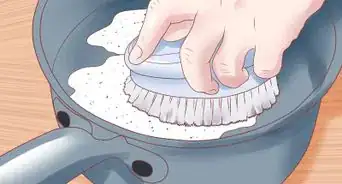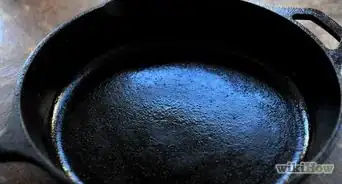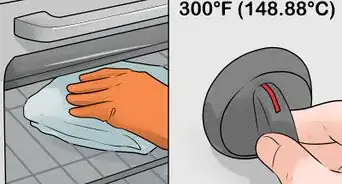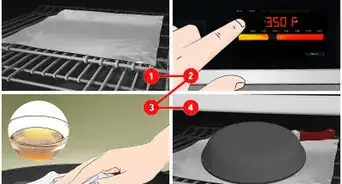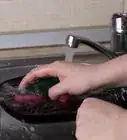This article was co-authored by Kadi Dulude. Kadi Dulude is a House Cleaning Professional and the Owner of Wizard of Homes, a New York City-based cleaning company. Kadi has over 10 years of experience and manages a team of over 90 registered cleaning professionals. Her cleaning advice has been featured in Architectural Digest and New York Magazine.
There are 9 references cited in this article, which can be found at the bottom of the page.
wikiHow marks an article as reader-approved once it receives enough positive feedback. In this case, several readers have written to tell us that this article was helpful to them, earning it our reader-approved status.
This article has been viewed 1,046,888 times.
Seasoning a cast iron skillet is necessary to create a non-stick surface and prevent rust. To preserve this seasoning, you need to take special care when cleaning.[1] With proper care, your cast iron skillet will improve with age and use, becoming a beautiful centerpiece of your cooking and, indeed, your kitchen.
Steps
Cleaning Your Skillet the Traditional Way
-
1Rinse the skillet out with hot water after cooking.[2] If your skillet is still hot, this is the best time to clean it. If your skillet has a distinct "lip" so that it holds water, you can pour water directly onto the hot pan--something you should not do with other kinds of cookware. It will hiss and steam dramatically, but this is fine. Take care not to get too close to the hot steam lest you risk a burn. Rinse it out once to remove many of the large pieces of food. Then fill it again so that the water fills the cooked on area.The exact amount is not important.[3]
-
2Bring the water to boil.[4] If your skillet still needs cleaning, or is cold, you can heat the pan up again. Carefully place the cast iron skillet back on the burner and heat the water up until it reaches a boiling point. Boil the water for several minutes to help dissolve food scraps.Advertisement
-
3
-
4Dump the dirty water in the sink. Return the cast iron skillet to the burner and turn the burner off.
- Use caution when transporting the skillet back and forth between the range and the sink. Because cast iron is an excellent conductor of heat, the handle, as well as all other portions of the skillet, will be extremely hot. Use a cloth or oven mitts to transport the skillet.
-
5Wet a couple paper towels and quickly wipe the surface of the skillet. If done correctly, the bottom of your paper towel should contain a dark layer of residue.[7]
-
6Apply a thin coating of fat, such as vegetable oil or shortening, to the surface of the skillet.[8] Vegetable sprays work especially well for this purpose. Apply or spray a dab of fat into the bottom of the pan; with a paper towel, wipe the fat into the bottom and the sides of the pan. This process should turn the pan's surface into a smooth, glossy finish.[9]
-
7Store in a cool, dry place. Cover with a paper towel instead of a lid to prevent moisture from building up inside the pan.[10]
Cleaning with Potatoes and Baking Soda
-
1Cut a raw potato in half or lengthwise, depending on the size of your skillet. Larger skillets may require you to cut the potato lengthwise for more surface area.
- This method of cleaning your cast iron pots and pans works great for tackling rust.
-
2Apply a thin layer of baking soda to the bottom of your potato. The baking soda is both a slight abrasive and a light but effective cleaner. Baking soda is renowned as a natural cleaning ingredient.
-
3Scrub the skillet with the potato and baking soda, taking extra care to clean the problem areas. Scrub the bottom of the pan, as well, as the sides. If the potato gets too slick, simply cut a slice off of it and apply another coating of baking soda.[11]
-
4Season your pan after cleaning. You'll probably need to re-season your pan after cleaning it with a potato and baking soda.
Methods That Do Not Help Clean a Cast Iron Skillet
-
1Avoid using soaps and detergents. Soaps and detergents are great at cleaning most cookery, but they should be avoided when it comes to cast iron pots and pans. The sulfides in most detergents bind to the oils in the skillet and strip them, leaving your skillet as naked and vulnerable as it was on the first day of its life.[12] It still can be re-seasoned, but it ends up being more work than necessary.[13]
-
2
-
3Try to avoid using steel wool to clean your cast iron cookery unless in dire need of cleaning. While steel wool is effective at removing food and other buildup, it cuts right through the seasoning and forces you to start at square one again.[16] Far better to stick to the potato method for cleaning (no pun intended).[17]
Expert Q&A
Did you know you can get expert answers for this article?
Unlock expert answers by supporting wikiHow
-
QuestionCan you clean rust off of a cast iron skillet?
 James SearsJames Sears leads the customer happiness team at Neatly, a group of cleaning gurus based in Los Angeles and Orange County, California. James and the team have nine years of experience and offer green cleaning, interior and exterior window washing, and general apartment cleaning services. He provides transformative cleaning experiences by reducing clutter and renewing your home environment. James is a Trustee Scholar at the University of Southern California.
James SearsJames Sears leads the customer happiness team at Neatly, a group of cleaning gurus based in Los Angeles and Orange County, California. James and the team have nine years of experience and offer green cleaning, interior and exterior window washing, and general apartment cleaning services. He provides transformative cleaning experiences by reducing clutter and renewing your home environment. James is a Trustee Scholar at the University of Southern California.
House Cleaning Professional
-
QuestionCan I use canola oil instead of vegetable oil?
 Community AnswerYes. Canola oil is a vegetable oil, along with peanut, corn, coconut, safflower, etc.
Community AnswerYes. Canola oil is a vegetable oil, along with peanut, corn, coconut, safflower, etc. -
QuestionHow do I remove buildup on my cast iron skillet?
 Community AnswerIf the buildup is from years of use, I would suggest a lye bath to remove it. Directions for the bath can be found online. Using a lye bath will require that you re-season your skillet.
Community AnswerIf the buildup is from years of use, I would suggest a lye bath to remove it. Directions for the bath can be found online. Using a lye bath will require that you re-season your skillet.
Warnings
- Avoid putting hot cast iron into cold water. This can cause cast iron to warp or crack.⧼thumbs_response⧽
- Cast iron skillets conduct heat up the handle, so be careful not to burn yourself by touching it with unprotected skin.⧼thumbs_response⧽
- Thoroughly dry any other kitchen equipment that you may store inside your cast iron skillet. A slightly damp pan will rust a cast iron skillet when stacked on top.⧼thumbs_response⧽
- A hot iron skillet looks identical to a cold iron skillet. Always use caution when a pan in on the stove for this reason.⧼thumbs_response⧽
References
- ↑ James Sears. House Cleaning Professional. Expert Interview. 28 August 2019.
- ↑ James Sears. House Cleaning Professional. Expert Interview. 28 August 2019.
- ↑ https://www.cooksillustrated.com/articles/381-how-to-clean-a-cast-iron-pan
- ↑ Kadi Dulude. House Cleaning Professional. Expert Interview. 22 September 2019.
- ↑ Kadi Dulude. House Cleaning Professional. Expert Interview. 22 September 2019.
- ↑ https://www.thekitchn.com/how-to-clean-a-cast-iron-skillet-cleaning-lessons-from-the-kitchn-107747
- ↑ https://fieldcompany.com/pages/how-to-clean-maintain-cast-iron-pan-skillet
- ↑ Kadi Dulude. House Cleaning Professional. Expert Interview. 22 September 2019.
- ↑ https://fieldcompany.com/pages/how-to-clean-maintain-cast-iron-pan-skillet
- ↑ http://www.lodgemfg.com/use-and-care/cast-iron-lets-cook
- ↑ http://www.thekitchn.com/tip-remove-rust-with-a-potato-108040
- ↑ James Sears. House Cleaning Professional. Expert Interview. 28 August 2019.
- ↑ https://www.rachaelrayshow.com/lifestyle/25865_how_to_clean_a_cast_iron_skillet
- ↑ http://www.southernplate.com/how-to-season-a-cast-iron-skillet/
- ↑ James Sears. House Cleaning Professional. Expert Interview. 28 August 2019.
- ↑ James Sears. House Cleaning Professional. Expert Interview. 28 August 2019.
- ↑ https://www.thekitchn.com/how-to-clean-a-cast-iron-skillet-cleaning-lessons-from-the-kitchn-107747
About This Article
To clean a cast iron skillet the traditional way, rinse the skillet out with hot water, then pour more water into the skillet and bring it to a boil. After the water has boiled for several minutes, lightly scrape the bottom and the sides of the skillet with a wide spatula to dislodge any remaining food scraps. Turn off the burner on your stove and carefully pour the dirty water into the sink, holding the skillet with oven mitts or a cloth. Wipe the surface of the skillet quickly with paper towels and apply a thin coating of vegetable oil to the skillet.

